The Samsung Galaxy Z Flip7 builds on the heritage of the original Flip (2020), Flip3 (2021), Flip4 (2022), Flip5 (2023), and Flip6 (2024), incrementally improving on previous generations as the technology becomes more Flip-friendly.
Only the Samsung Galaxy Z Flip7 has taken one step forward and two steps back. It improves some Flip6 things, like the 4.1” cover screen, but the use of a Samsung Exynos 2500 processor is a step back over the Qualcomm SD8 Elite for Galaxy in all its S25 series and the Fold7.
The Exynos chip choice impacts speed, phone reception strength, Wi-Fi signal stability, GPS stability and throttling. Simply put, it is not the processor expected in Samsung’s premium Flip.
But Samsung users are a loyal lot, and perhaps the issues we found won’t be as relevant to them. Our job is to objectively point out both the positive and negative aspects.
What about the Samsung Galaxy Z Flip7 FE?
It is a lower-cost version. Here are the key differences.
| Samsung Galaxy Z Flip7 | Samsung Galaxy Z Flip7 FE | |
| Website | Product Page | Product Page |
| Price | $1799, 12/256GB $1999, 12/512GB | $1499, 8/128GB $1599, 8/256GB |
| Internal screen | 6.9” 2520 x 1080 AMOLED 120Hz, 2600 nits peak 8-bit/16.7m colours Not for PWM-sensitive | 6.7” 2640 x 1080 AMOLED Same Same Same |
| Cover Screen | 4.1” 1048 x 920 AMOLED 120Hz, 2600 Nits peak | 3.4” 748 x 720 AMOLED 60Hz, 2600 nits peak |
| SoC | Samsung Exynos 2500 3nm | Samsung Exynos 2400 4nm |
| Wi-Fi | 7 BE Dex support | 6E AXE No Dex support |
| Battery | 4300 mAh 25W capable | 4000 mAh 25W capable |
We won’t be covering AI features
You will find a good overview What is Samsung Galaxy S25 AI all about? And you can read more in Samsung Galaxy S25 Ultra – its best glass slab yet.
The primary reason to buy a Flip is its smaller pocketable size. AI, if you use it, is a bonus. Note that Samsung advises that off-device AI may incur a charge or subscription fee from late 2025.




Consumer advice
Samsung does not publish detailed specifications, which we need as a basis for a comparative deep-dive review. So, forgive us if there are any errors—this is what our test equipment and analytical software show. To illustrate the point, we have used ‘Not Disclosed’ in the screen review to show how specs we consider important are omitted.
Australian Review: Samsung Galaxy Z Flip7, 12/256GB, SIM and eSIM, Model SM-F766
| Brand | Samsung |
| Model | Samsung Galaxy Z Flip7 |
| Model Number | SM-F766 |
| RAM/Storage Base | 12/256 |
| Price base | 12/256GB $1700 12/512GB $1999 |
| Warranty months | 24 |
| Teir | Flip |
| Website | Product Page |
| Manual | Manual |
| From | Samsung Online and approved retailers |
| Made in | Korea |
| Company | Samsung is a South Korean multinational manufacturing conglomerate headquartered in Samsung Town, Seoul, South Korea. Samsung Electronics (the world’s largest information technology company, consumer electronics maker and chipmaker. |
| More | Samsung publishes few meaningful specifications. Most of these come from testing and analytical software. |
| Test date | 14-29/08/2035 |
| Ambient temp | 10-20° |
| Release | August 2025 |
| Other models not for Australia (Don’t buy) | Australia gets SM-F766B (followed by colour and memory codes). Do not buy models with U or any other code. |
* Grey market – no Australian warranty, and 5G may not work here
We strongly recommend purchasing a genuine model with Australian firmware. Check Settings, About Phone, Regulatory Labels and Australian RCM C-tick mark. Insist on a screen grab if you buy anywhere else.
Australian certified phones use unique Australian 5G sub-6Ghz and 5G low-band frequencies, requiring local activation first. Read Don’t buy a grey market smartphone.
Ratings
We use the following ratings for many of the items below. CyberShack regards a score between 70 and 80/100 as a fit-for-purpose pass mark. You can click on most images to enlarge them.
- Fail (below expectations), and we will let you know if this affects its use.
- Pass(able) rating that is not as good as it should be.
- Pass (meets expectations).
- Pass ‘+’ rating to show it is good, but does not quite make it to Exceed
- Exceed (surpasses expectations or is the class leader).
How to make the best use of this deep dive review
We tested over 70 different aspects and uncovered nearly 300 key data points about the device. Overall reviews can reach a few thousand words. So, if you are keen, this is the world’s most comprehensive review!
If you want to see our impressions only, they are listed at the beginning of each table. At the end, you will find CyberShack’s view, competitor analysis, and ratings. Ratings are based on the price bracket and expectations, so a $200 phone may score as well as a $2000 phone—we compare like with like.
First Impression – it’s a Flip, if that is what you want
My brother uses a Moto Razr 50 Flip Ultra (2024) and loves it (but then he is a Trekkie and Thunderbirds tragic), and it gets its share of admirers. He looked closely at the Samsung Galaxy Z Flip6 and, well, Motorola’s cover screen and specs ate that for breakfast.
The 2025 Flip7 addresses many of the issues, and a lower-cost Flip7 FE is also available. Read Samsung Galaxy Z 2025 Fold and Flip 7 and Watch 8 are now available.
Screen – Pass
The cover screen is now 4.1” (less the two camera sensors and flash cutout). It is heavily widget-driven, and while it does a few interesting things, you still need to open the Flip much of the time.
Then you get the internal 21:9 screen, taller and narrower than most smartphones. The key advantage of the cover screen is notifications and in camcorder mode.
The internal screen is now 6.9” and it has been beefed up with new manufacturing tech, including ultrathin foldable AMOLED and cover glass under a pre-fitted PU protector.
Both have bright, infinite-contrast AMOLED screens. The colours are oversaturated in Natural mode, at 118% of sRGB and 87% of the 16.7M colours of the DCI-P3 movie gamut (approximately 50% of 10-bit/1.07 billion colours).
My only comment is that more premium phones now feature 10-bit/1.07 billion-colour AMOLED screens (such as the Motorola Razr 60), where accurate colour matching is essential for creators, photographers, and videographers. Read 8-bit versus 10-bit screen colours. What is the big deal?
One area that causes us concern is Samsung’s use of Pulse Width Modulation (PWM) dimming (and the screens it supplies to Apple and Google). This has a deep 60% modulation at low 120/240/480 Hz levels, which can affect PWM-sensitive individuals.
Samsung claims a peak brightness of 2600 nits, but this is for HDR10+ playback content measured in a 2% screen window (Test: 1800). This is not representative of typical screen brightness, which is around 437 nits, and in auto brightness, momentarily peaks at 750 nits.
Cover screen widgets
It is widget-driven. There is an App called Good Lock and MultiStar that can run apps, but these are still in a 16:9 ratio on an approximately 1:1 screen. You can also:
- Wake the screen: Double-tap the cover screen or press the Side key.
- View notifications: Swipe right from the cover screen to see system alerts and messages.
- Access controls: Swipe down on the cover screen to find system controls like flashlight and camera access.
- Browse widgets: Swipe left to view your selected widgets, such as weather, calendar, or media controls.
- Answer calls: Swipe right on an incoming call to answer or left to reject it


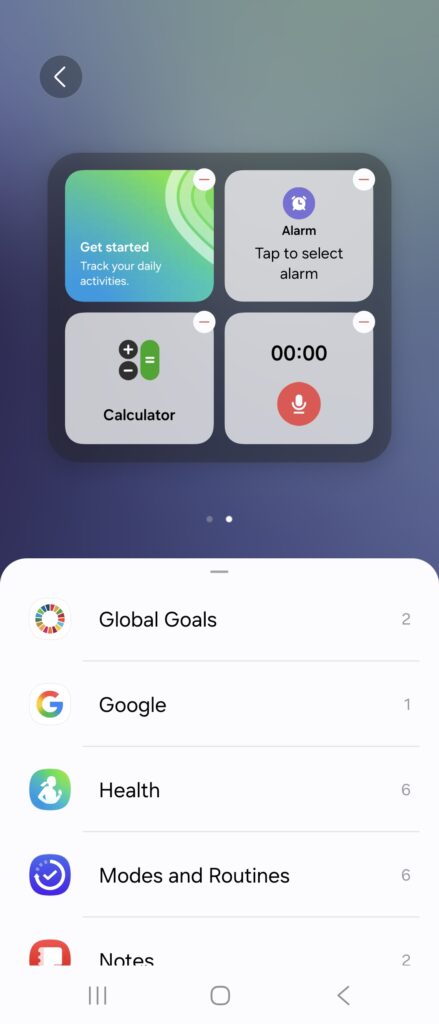
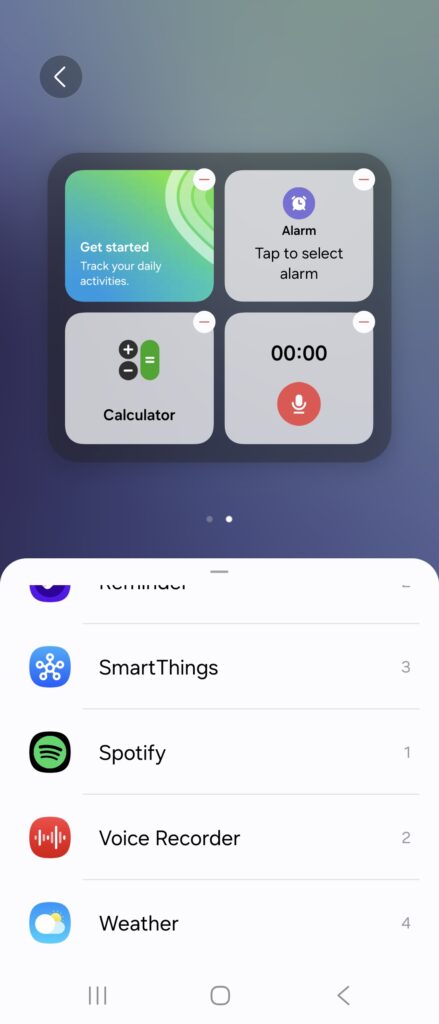

Screen specs
| Size | 6.9″/4.1″ |
| Type | Dynamic AMOLED 2X/Super AMOLED |
| Flat, Curve, 2D, 3D | Flip folded/’notch’ cut around dual camera. |
| Resolution | 2520 x 1080/1048/948 |
| PPI | Not disclosed 400/342 |
| Ratio | Not disclosed 21:9/Approx 1:1 |
| Screen to Body % | Not disclosed 88.7%/covers half the front of the phone with cutouts for two camera sensors and flash |
| Colours bits | 8-bit/16.7m/same |
| Refresh Hz, adaptive. | Samsung claims 1-120Hz, but it is stepped from 10/24/30/48/60/90/120Hz Adaptive up to 60 or 120Hz Cover: Not disclosed. Test 120 Hz |
| Response 120Hz | Not disclosed |
| Nits typical, test | Not disclosed Test: 437 Typical Auto brightness sunlight 750 |
| Nits max, test | Claim: Peak 2600 Test 5% window and HDR10+ content 1800 |
| Contrast | Infinite |
| sRGB | Not disclosed. Please note that these measurements are of 16 million colours, not of 1.07 billion colours. Vivid: 143% Natural: 118% |
| DCI-P3 | Not disclosed. Note as above Vivid: 100% Natural: 87% |
| Rec 2020 or other | Not disclosed |
| Delta E (<4 is excellent) | Not disclosed Test: 2.4 |
| HDR Level | Not disclosed Internal HDR10+ (no Dolby Vision) External: No |
| SDR Upscale | No |
| Blue Light control | Yes |
| PWM if known | Cycles 120/240/480 Hz with 60% modulation depth (deep). Not for PWM-sensitive people. |
| Daylight readable | Yes |
| Always on Display | One control for internal and external screens |
| Edge display | Yes |
| Accessibility | Full suite of enhancements |
| DRM | Widevine L1 1080p HDR |
| Gaming | Game mode, but the screen is too soft for game use. A fingernail can scratch it. |
| Screen protection | Internal: Plastic and replaceable screen protector (can only be fitted by Samsung) External: Gorilla Glass Victus 2, Mohs 6 hardness |
| Comment | Despite the fold-flat hinge, the internal screen still has a noticeable crease made worse by the constant swiping left/right/up/down. Samsung persists in using an 8-bit/16.7M colour screen while others use 10-bit/1.07 billion colours. |


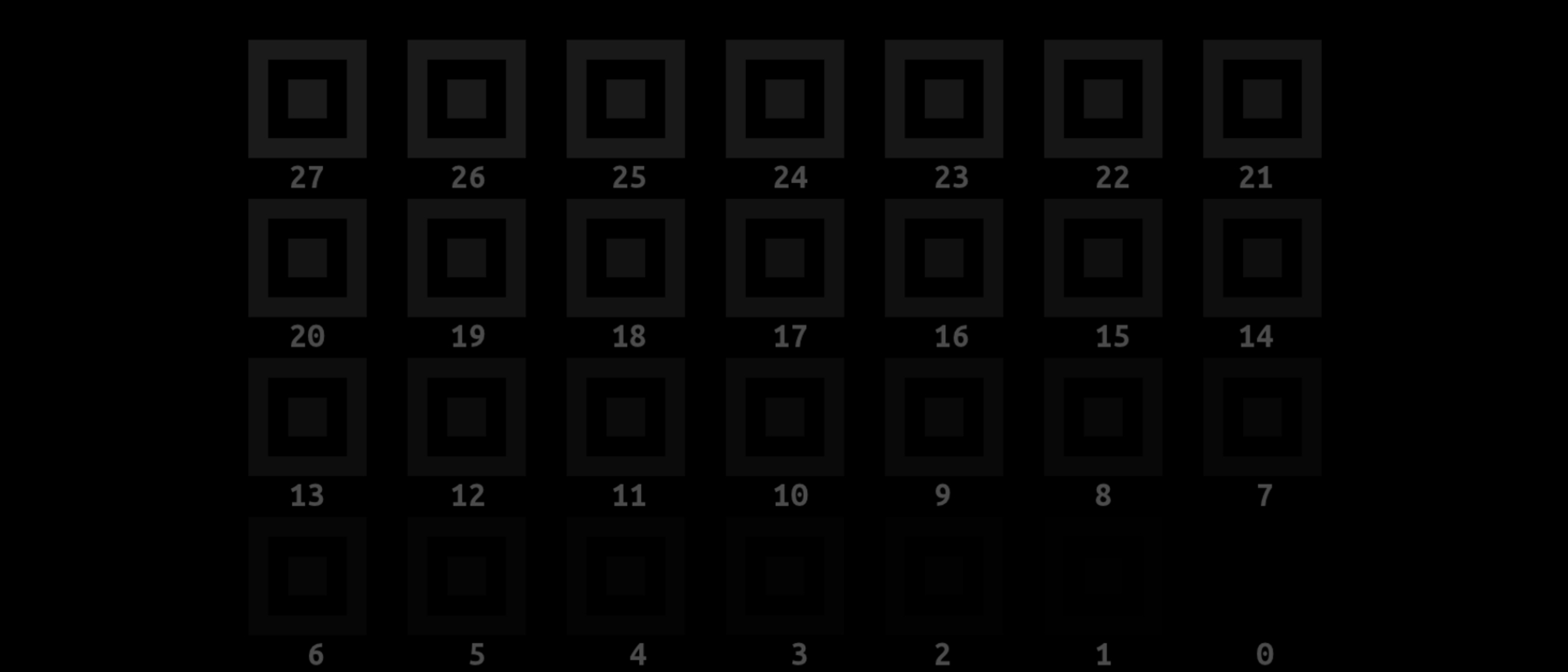


Processor – Pass (it should have been ‘Exceed’ for a premium device)
Samsung is using its Exynos 2500 processor, a significant departure from the traditional Qualcomm SD8 Elite for Galaxy found in the S25-series and the Fold7.
It is at least 30% slower than the Qualcomm. It introduces new issues with its modem (poor phone signal strength), GPS (variable accuracy from two to seven metres), and Wi-Fi 7 (variable signal strength). For convenience, the SD8 Elite for Galaxy results are in brackets below.
We are not saying that the Exynos 2500 is a bad chip; it is just not what is expected, considering other flagship devices are significantly better.
| Type | Samsung Exynos 2500 |
| nm | 3 |
| Cores | 1 x 3.3, 1 2 x 2.75, 5 x 2.36 and 2 x 1.8 GHz |
| GPU | Xclipse 950 based on AMD’s RDNA 3 architecture. |
| Modem | Exynos 5400 includes Wi-Fi 7, BT 5.4, GPS and direct satellite SMS for emergency messaging (where available). |
| AI TOPS OR Multi-thread Integer Operations Per Second (INOPS) GINOPS = billion | Claimed 59 TOPS Geekbench AI Geekbench AI (S25 Ultra, last number in brackets) CPU: 2373/2274/3738 (4968) GPU: 1738/2745/2016 (2392) NNAPI: 587/576/1245 (1549) QNN: 3912/32806/51647 (61049) AiTuTu: 54,378 (67,171) AI Benchmark 6: 7008 (12807) GFLOPS: 23.33 (22.77) GINOPS: 31.08 (37/97) |
| AnTuTu | 1,718,515 (2,143,922) |
| Geekbench 6 Single-core | 2413 (3,155) |
| Geekbench 6 multi-core | 8285 (9,772) |
| Like | It’s a reasonable effort, but around 30% slower than the Samsung Galaxy S25 Ultra and the Galaxy Z Fold7 with the SD 8 Elite for Galaxy. Benchmarks |
| GPU Test | |
| OpenCL | 19,174 (21,108) |
| Vulcan | 20,045 (23,759) |
| RAM, type | 12GB LPDDRX5 |
| Storage, free, type | 256 GB UFS 4.0 (195 GB free) |
| micro-SD | N/A |
| CPDT internal seq. Read MBps sustained/peak | 1490/2490 (2930/3860) |
| CPDT internal seq. write MBps sustained/peak | 887/1460 (1330/1740) |
| CPDT microSD read, write MBps | N/A |
| CPDT external (mountable?) MBps | Won’t test – seen as external storage, but can’t be mounted as internal storage. |
| Comment | UFS 4.0 is the fastest storage available. However, without mountable storage, seen as internal storage, videographers and vloggers will soon run out of space. |
Throttle under load – Passable
This is a powerful processor, but it throttles 37% under 100% load and does not recover. It is not for gamers, videographers and heavy users.
| Max GIPS | 421,409 |
| Average GIPS | 305,158 |
| Minimum GIPS | 196,414 (under half the maximum GIPS) |
| % Throttle | 37% |
| CPU Temp | 50° |
| Comment | This exhibits significant throttling under load. It’s not for gamers (the screen precludes that) and power users. While the CPU remains relatively cool at 50°, the screen reaches 47° – warm to touch. |

Comms – Passable
When we set up the device, it only recognised 2.4 and 5 GHz SSIDs. Once it was finished and all updates applied, it recognised the Wi-Fi 6 GHz band. That is not a big deal, just unexpected.
During testing for over an hour, we noticed extreme variance in Rx and Tx data transfer rates and rebooted the rock-solid TP-Link Deco BE85 Wi-Fi 7 BE22000 tri-band mesh router – If you feel the need for massive, distributed speed reference router, hoping it was NBN’s fault. It was not.
We suspect it is the aerial design and the modem’s ability to sustain the load. This suspicion was reinforced by the GPS accuracy varying from two to seven metres, and it also accounts for the weaker phone signal strengths.
We then repeated all tests with a tripod mount (to remove any interference from holding it), and the results were the same.
What does this mean? To the average user, nothing. To the power user, it means that Wi-Fi 7 6 GHz speeds will fall below Wi-Fi 6E speeds.
| Wi-Fi Type, model | Wi-Fi 7 BE EHT 320, 2 x 2 Rx/Tx, 4096 QAM. Should be capable of MLO 5802 Mbps full duplex. |
| Test 2m -dBm, Rx/Tx Mbps | -47/3170 to 4804/2764 to 4932 |
| Test 5m | -55/3485 to 3843/1056 to 4163 |
| Test 10m | -66/1793 to 2882/960 to 2822 |
| BT Type | 5.4 |
| GPS single, dual | The SoC is capable of much more, but we suspect that it does not have the aerials for dual or tri-band operation, as the accuracy varies from 2 to 7 metres. GPS, GLONASS, BeiDou, Galileo, and QZSS |
| USB type | USB-C 3.1 Gen 1 5 Gbps is not implemented for external mountable SSD use. |
| ALT DP, DeX, Ready For | Supports Alt DP 1.2 1080p over USB for DeX by cable. No longer supports DeX to PC; use Microsoft Link to Windows instead. |
| NFC | Yes |
| Ultra-wideband | No |
| Sensors | |
| Accelerometer | Yes |
| Gyro | Yes |
| e-Compass | Yes |
| Barometer | Yes |
| Gravity | |
| Pedometer | |
| Ambient light | Yes |
| Hall sensor | Yes |
| Proximity | Yes |
| Other | Fingerprint sensor |
| Comment | There is something not quite right with the comms. Huge variances in Wi-Fi speeds and GPS accuracy, as well as poor phone antenna signal strength. This is not what we expect of a Flip. |

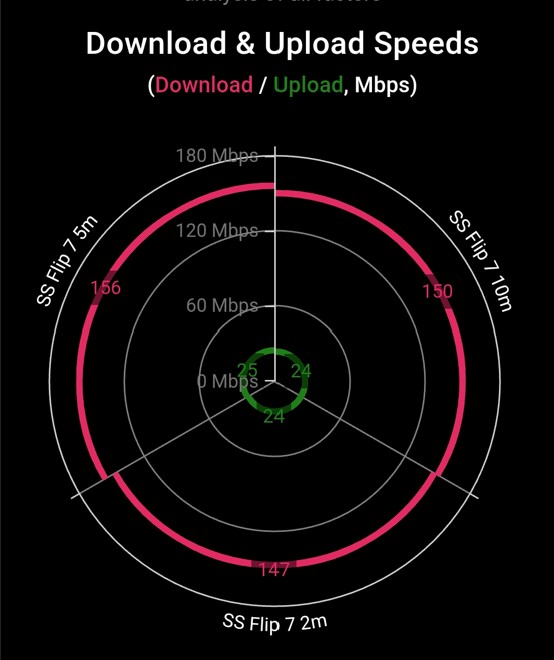


4/5G – Passable
A premium phone should have excellent reception, at least as good as the Samsung Galaxy S25 Ultra or Fold7. This only found the closest tower at 2.5 picowatts (typically the S25U finds four at up to 20 pW).
And to top that off, the system only supports DSDS (Dual SIM, Dual Standby), where the S25-series and Fold7 have DSDA (Dual SIM, Dual Active).
In outdoor tests, it failed to find a usable 5G signal. While not unusual, we expect a premium phone will.
In indoor tests, there was no usable indoor 4G or 5G signal.
I hope Samsung receives this message and is working on firmware fixes, as it makes this phone a city and suburb-only device, where there is a good, strong signal.
| SIM | SIM and eSIM |
| Active | DSDS (Dual SIM, Dual Standby). We were unable to find a setting to activate DSDA (Dual SIM, Dual Active), which is typically found in premium phones. |
| Ringtone single, dual | Single |
| VoLTE | Yes |
| Wi-Fi calling | Yes |
| 4G Bands | B1, 2, 3, 4, 5, 7, 8, 9, 12, 13, 17, 18, 19, 20, 25, 28, 38, 39, 40, 41, 66 |
| Comment | All Australian and most world bands |
| 5G sub-6Ghz | N1, 2, 3, 5, 7, 8, 12, 20, 25, 28, 38, 40, 41, 66, 71, 77, 78 |
| Comment | All sub-6Ghz and 5G low bands |
| mmWave | No |
| Test Boost Mobile, Telstra | |
| DL/UL, ms | 37.3/33/35ms (average) |
| Tower 1 -dBm, fW or pW | 4G Band 3: -86 to -92. 2.5 pW to 631 fW (very low) 5G Band 7: -106 to -114, 4 to 25 fW (not usable) |
| Tower 2 | No |
| Tower 3 | No |
| Tower 4 | No |
| Indoor | 4G: No service 5G No service Wi-Fi calling only |
| Comment | This phone has poor antenna strength, likely due to the Samsung modem. It is for city and suburbs only, and in our test had no indoor 4 or 5G phone reception. |

Battery – Pass
It has dual batteries in serial. The maximum charge is 25W (tested to 23W with Samsung’s 25W charger) and takes a pretty slow 1 hour and 38 minutes. It works with any other PD/PPS charger, but you will likely get 9V/2A/18W to 23W.
Samsung does not reveal battery charge cycles, and in the past has used ‘5’ batteries, which should mean 500 full recharge cycles. These batteries are made in Vietnam by Samsung but don’t have a ‘5’. We can only assume that, as it is not using the new Si/C anode battery, it remains the same. Update: The European Union’s EPREL energy certification states the Flip7 battery should retain over 80% of its original capacity even after 2 x 1000 (dual battery) full charge-discharge cycles.
We no longer deduct points for not supplying a charger, but remember it will cost about $30.
Please note the comments on the video loop time. AI shuts down the phone, effectively turning it into a media player. It is not indicative of typical screen-on time.
Typical users will charge daily. Heavy users may need a top-up at the end of a workday.
| mAh | 4300 mAh dual battery in serial 3.9V/2.985A/11.65W 3.9V/1.189A/4.64W |
| Charger, type, supplied | Not supplied 25W capable with Samsung 25W charger 9V/2.77A/24.93W otherwise will get from 9V/2A/18W up to 23W. |
| PD, QC level | 3.0/2.0 |
| Qi, wattage | 15W, but most Qi-certified chargers only provide 10W. |
| Reverse Qi or cable. | Supports Qi reverse 5V/1A/5W maximum (4.5W) |
| Test (60Hz or adaptive screen) | Adaptive |
| Charge % 30mins | 40% |
| Charge 0-100% | Test: Anker GaN 140W at 20W 1 hour 38 minutes. Note maximum wattage is only applicable when the battery is flat. It decreases as the battery fills. |
| Charge Qi, W | 2 hours at 15W Using Belkin Boost Charge 15W fast wireless charge 3 hours at 10W |
| Charge 5V, 2A | Approx 5 hours |
| Video loop 50%, aeroplane mode | 30 hours Note, this is no longer an accurate measurement of screen-on time, as AI puts the rest of the phone to sleep, making it a pure media player. |
| PC Mark 3 battery | Samsung ‘games’ most battery tests so we cannot rely on this one. Accubattery: 18 hours typical use |
| GFX Bench Manhattan battery | Out of Memory Error |
| GFX Bench T-Rex | 424.1 minutes (7 hours) 6678 frames |
| Drain 100-0% full load screen on | 5 hours 10 minutes Accubattery: 5 hours |
| mA Full load screen on | 1500-1550 at 50% brightness 2500-2600 at 100% brightness |
| mA Watt idle Screen on | 250-300 at 50% brightness 750-800 at 100% brightness |
| Estimate loss at max refresh | Tested on Adaptive mode. Battery life may be reduced by an additional 20% with a 120Hz refresh rate. |
| Estimate typical use | Typical users will charge daily. Heavy users may need a top-up at the end of a workday. |
| Comment | Carry a charger (shame Samsung does not provide one). |
Sound hardware – Pass
Sound hardware is different to the sound signature (next section). Overall, apart from the lack of some aptX codecs, it is fit-for-purpose. Note: It lacks an internal DAC for USB earphones (you need an external USB-C DAC).
| Speakers | Stereo – top earpiece and bottom down-firing. – flips between portrait and landscape mode. |
| Tuning | Not specified – probably AKG |
| AMP | 2 x TFA98XX 1.6W |
| Dolby Atmos decode | Yes, down mix to two speakers. |
| Hi-Res | Headphones only. UHQ upscaler virtualises 2.0 to hi-res |
| 3.5mm | No and no DAC for USB headphones |
| BT Codecs | SBC, AAC, aptX, LDAC and Samsung Scalable Codec. |
| Multipoint | Yes |
| Dolby Atmos (DA) | Yes – auto, movie, music, voice and games mode |
| EQ | Balanced, Smooth, Clear, Bass Boost, Dynamic, Treble Boost, Custom. Also Dialogue Boost (1-4kHz) and UHQ upscale. |
| Mics | 4 |
| Test dB – all on EQ flat DA off | |
| Volume max | 83 |
| Media (music) | 81 |
| Ring | 80 |
| Alarm | 79 |
| Notifications | 79 |
| Earpiece | 55 |
| Hands-free | Four mics – two top and two bottom. Decent noise cancellation and volume for hands-free use. |
| BT headphones | Excellent left-right separation and DA make quite a difference with DA content. |
Sound quality – Passable
We use a white noise generator to determine the micro speaker’s native sound signature. From there, you can use an EQ or preset to recess that, but you cannot enhance it. In this case, EQs and presets make little difference.
It is an odd signature – mostly mid (for clear voice), but a very messy mid/high treble makes music harsh.

| Deep Bass 20-40Hz | Nil |
| Middle Bass 40-100Hz | Nil |
| High Bass 100-200Hz | Very slow build to 1 kHz |
| Low Mid 200-400Hz | Very slow build to 1 kHz |
| Mid 400-1000Hz | Very slow build to 1 kHz |
| High-Mid 1-2kHz | Flat to 10 kHz |
| Low Treble 2-4kHz | Flat |
| Mid Treble 4-6kHz | Flat |
| High Treble 6-10kHz | Flat |
| Dog Whistle 10-20kHz | A steep linear decline to 20 kHz and a very messy high treble. |
| Sound Signature type | It is a cross between a very late Mid signature and Bright Vocal (bass recessed, mid, treble boosted). You get clear voice, but the music sounds harsh. |
| Soundstage | There is a slight bias to the bottom speaker, but otherwise decent separation. Dolby Atmos widens the soundstage slightly, allowing you to hear some height in landscape mode, which extends to the top of the screen. |
| Comment | It lacks musically important low-mid bass, and the high bass is delayed. Mid and low-mid treble are fine for music genres that don’t need bass. Treble is harsh. |
Build – Pass+
Samsung is synonymous with well-made gear. The Samsung Galaxy Z Flip7 looks and feels prestigious in every way. However, when folded, it is not 13.7mm, but rather over 16mm, including the camera bump (most phone measurements exclude this).
We also need to point out that while the SoC is suitable for gaming, the screen has a Mohs hardness of 2 – a fingernail can score it. It is not a gamer’s screen.
It has an IP48 rating. The 4 means effective against >1mm particles characterised by ‘Most wires, slender screws, large ants, etc.’ It is a rubbish rating in that it does not protect against <1mm particles like pocket lint, dust, etc.
Have a look at the JerryRig video below. His primary concern is that the inner and outer screens must be removed to replace the batteries, and that breaking these is almost certain, resulting in a A$1,000 replacement cost.
| Size (H X W x D) | Unfolded: 166.7 x 75.2 x 6.5 Folded: 85.5 x 75.2 x 13.7 |
| Weight grams | 188 |
| Front glass | None – foldable AMOLED |
| Rear material | Gorilla Glass Victus 2 (cover screen and rear panel) |
| Frame | Aluminium |
| IP rating | Not disclosed It is IP48. 4: indicates protection against solid objects larger than 1mm, so fine dust or sand can still get inside 8: indicates protection against submersion in 1.5m water for 30 minutes. Liquid damage is not covered by warranty. |
| Colours | Blue Shadow Jet Black Coral Red Mint |
| Pen, Stylus support | Inner Screen Cost $662 Cover Screen $303 Samsung Repair Cost Estimator |
| Teardown | Jerry Rig Durability – see below |
| In the box | |
| Charger | No |
| USB cable | Very short USB-C to USB-C 3W (25W maximum) |
| Buds | No |
| Bumper cover | No |
| Comment | Bare phone and short charge cable |
OS – Android 16 with seven more to come – Exceed
Samsung’s UI 8 is well done. It handles multitasking well and is overall more usable than pure Android. But it is becoming overly complex with multiple menu levels and some confusing options.
Android users will find that Samsung has substituted an almost complete set of alternatives to Google’s Gmail, Phone, Calendar, Contacts, and Photos. These make it easy to use Samsung backup, but very hard to back up to your Google account or go back to another Android phone. We recommend using Google Apps whenever possible.
Samsung also requires you to log in to your Samsung Account to use Samsung apps, services, backup, or AI features. This involves agreeing to some 40,000 legalese words in ten nested policies with privacy implications. It is in addition to Google’s 8,000-word simple English terms, which are easier to accept.
We remind you that its AI features are detailed in a separate post, and some may incur a cost later this year.
| Android | 16 |
| Security patch date | 1 June 2025 (current in late August) |
| UI | One UI 8.0 |
| OS upgrade policy | 7 years to 2032 |
| Security patch policy | 7 years to 2032 |
| Bloatware | Samsung’s alternative to the Google suite. Microsoft suite and OneDrive (requires subscription). |
| Other | Selection of Galaxy Apps. Consumer Advice: If you intend to use other Android brands in the future, consider using Google Apps rather than being locked into the Samsung ecosystem. |
| Comment | Great upgrade policy. You need to evaluate if AI will be worth the premium. |
| Security | |
| Fingerprint sensor | GW39B on the power key |
| Face ID | 2D |
| Other | Knox and Secure folder |
| Comment | One of the more secure Android devices |
Samsung Galaxy Z Flip7 rear camera – Good but not class-leading
We noticed that all the international reviews have different Ultra-wide and selfie sensors (Samsung 3LU and 3JI), which makes a difference compared to the Australian version, which uses a Sony IMX 825 for both.
The main work is done by the 50MP Samsung S5KGN3 (the same as the 2024 Flip, S25 FE and Fold7). It is a good low-profile sensor for this format, although there is no technical information for this sensor.
Also note that the inner and cover screen colours are more intense than the video or photo. While it is not a huge issue, professional videographers and photographers will be disappointed.
The Ultra-wide is a fixed-focus lens, lacking HDR and macro capabilities. Its colours are more intense than the primary sensor.
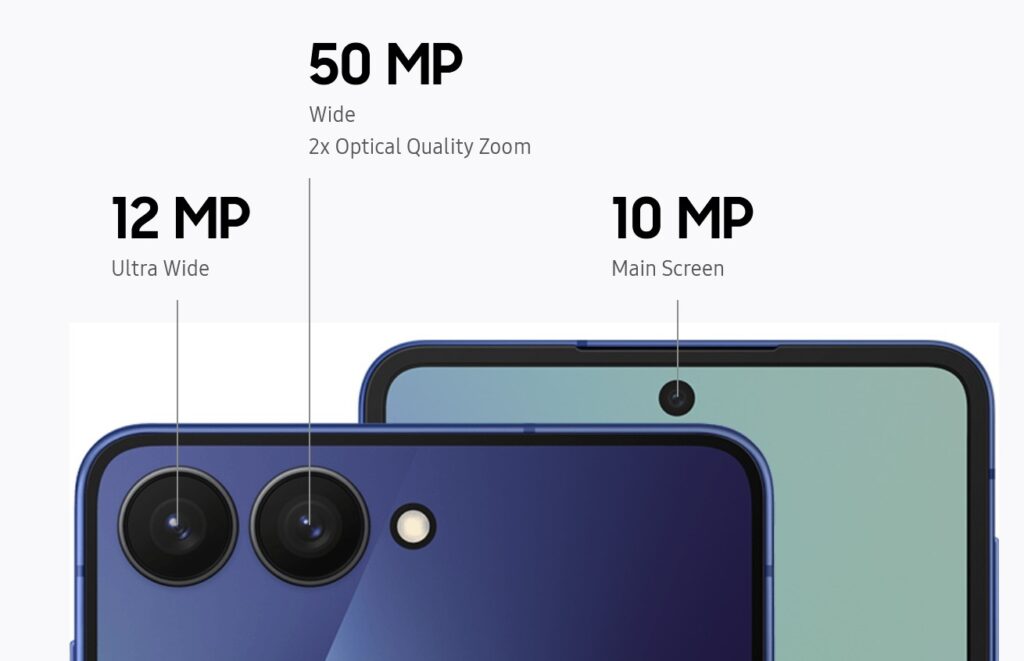
Test photos


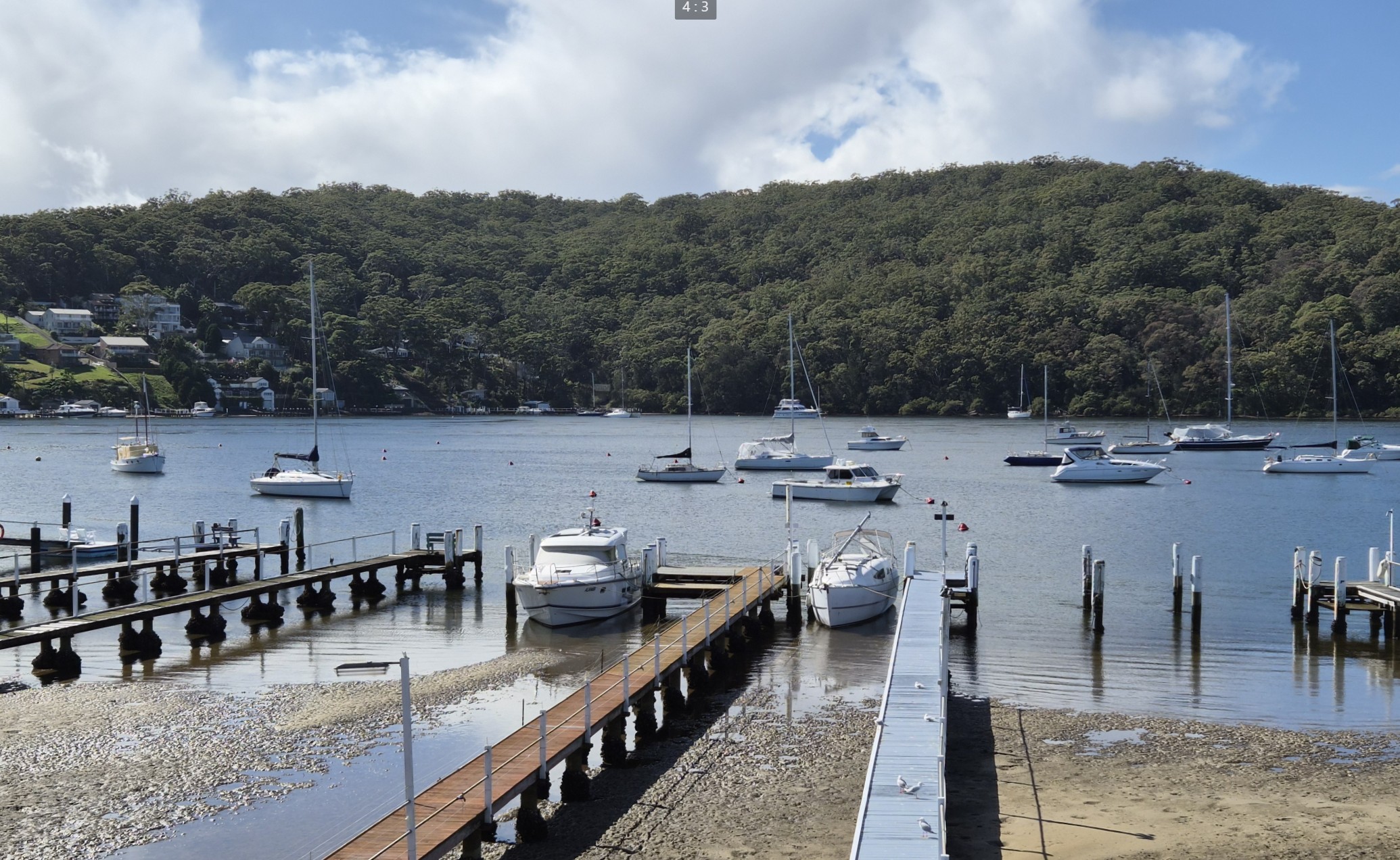
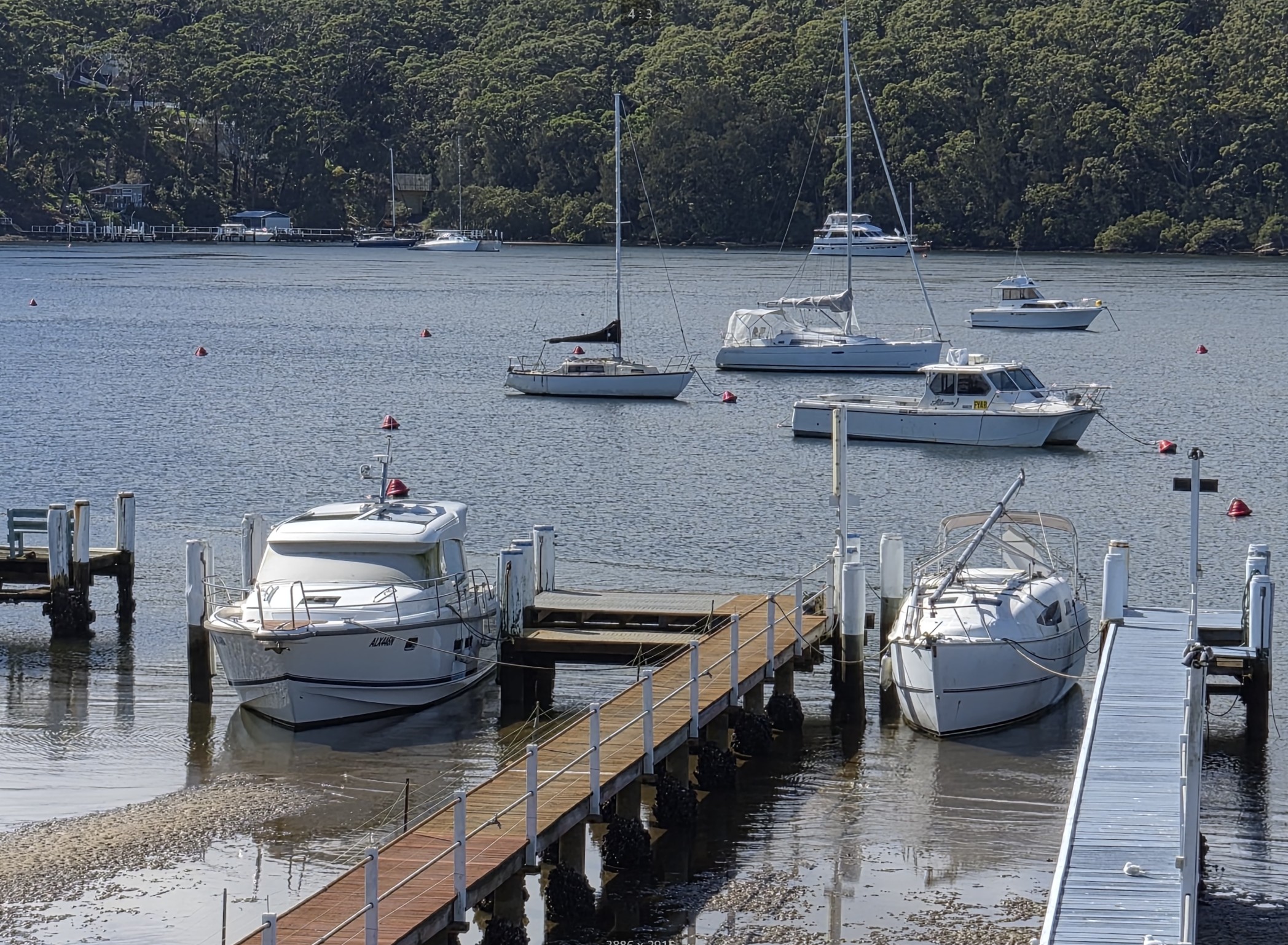

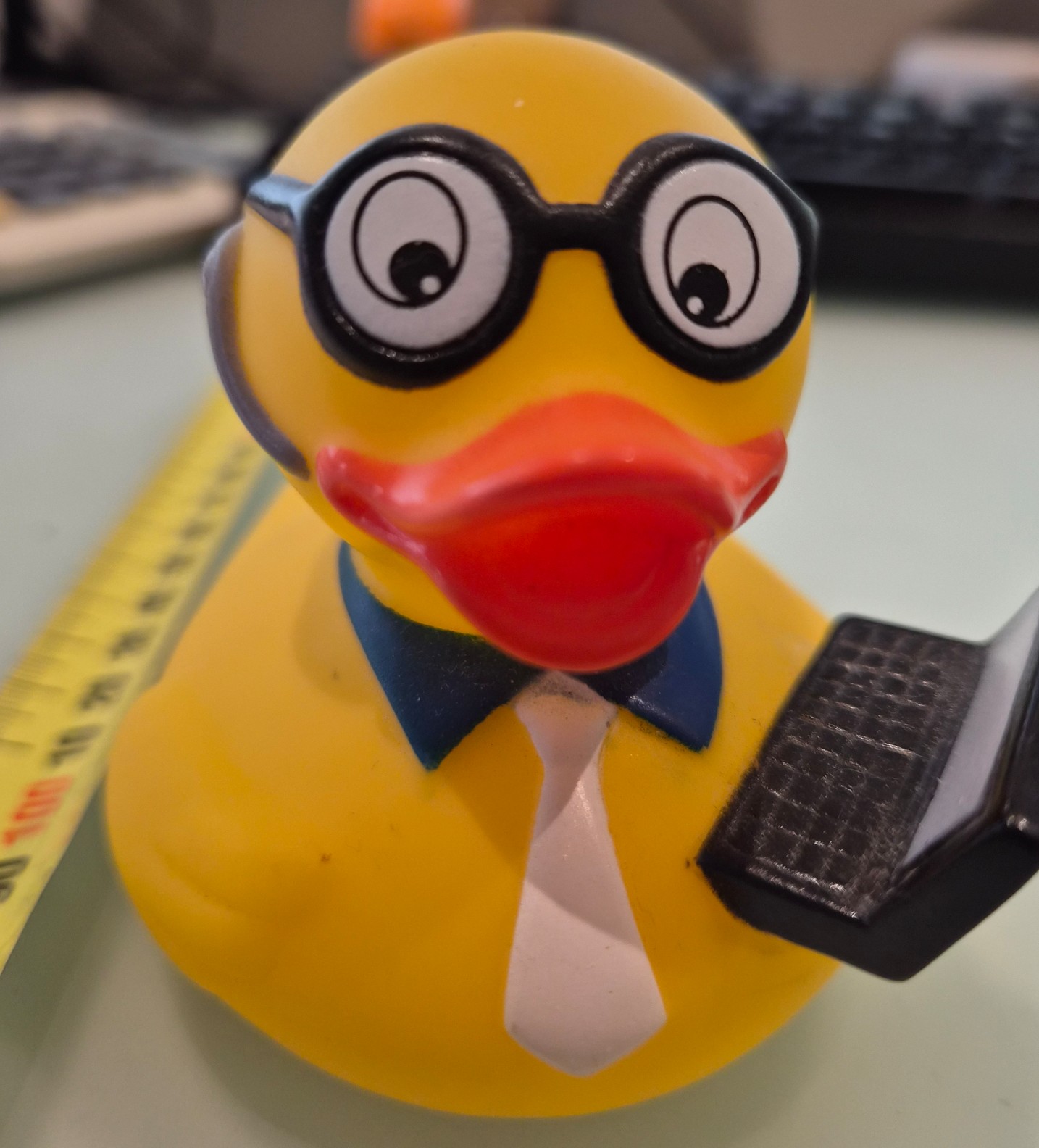


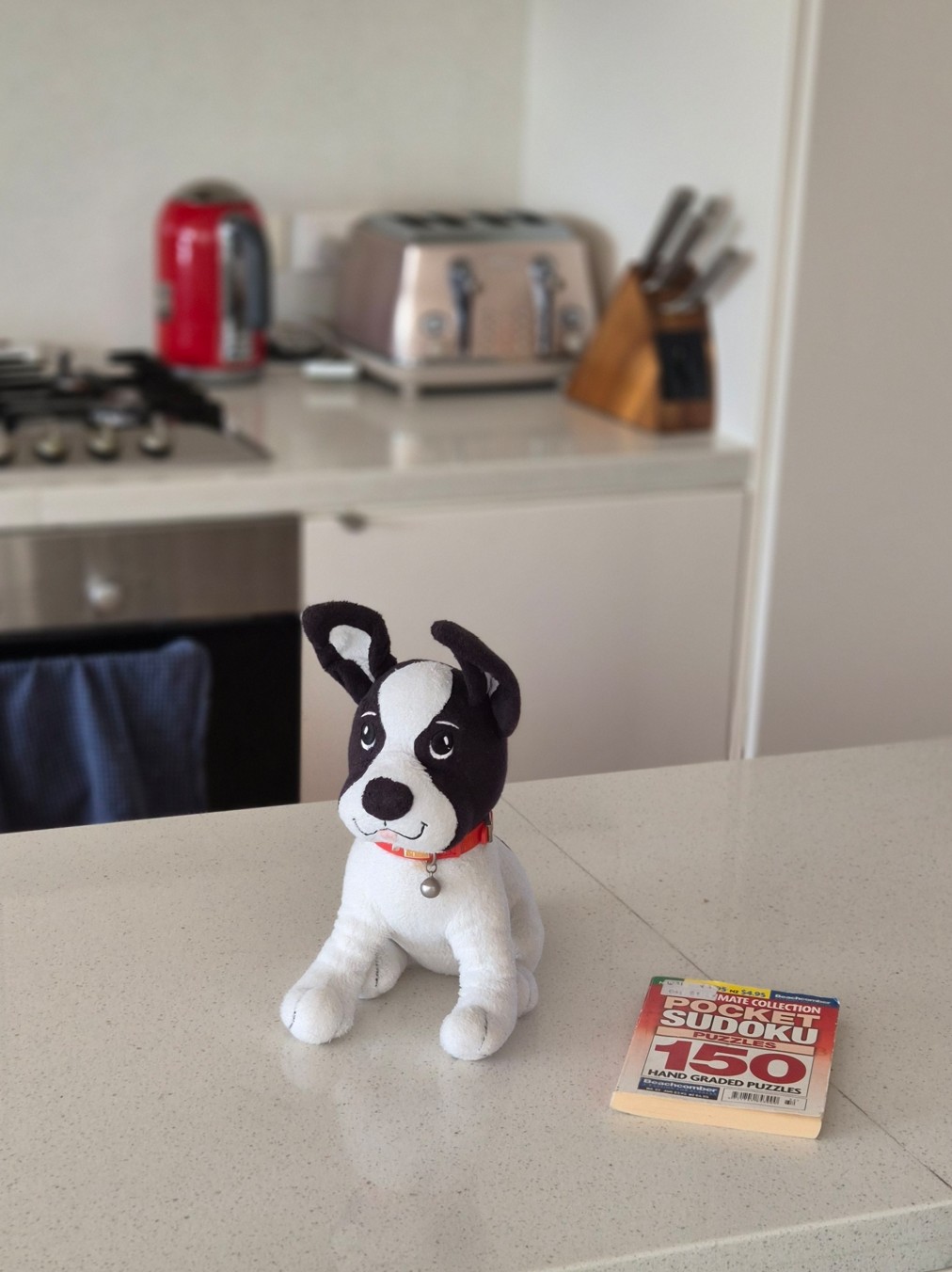




Camera Specs
| Rear Primary | Wide |
| MP | No real specs disclosed 50MP bins to 12.5MP |
| Sensor | Samsung S5KGN3 |
| Focus | PDAF |
| f-stop | 1.8 |
| um | 1 bins t5o 2 |
| FOV° (stated, actual) | 74.1 to 86.7° |
| Stabilisation | OIS |
| Zoom | 10X with 4.2 digital crop |
| Rear 2 | Ultra-wide (no macro) |
| MP | 12MP |
| Sensor | Sony IMX 825 |
| Focus | Fixed focus |
| f-stop | 2.2 |
| um | 1.12 |
| FOV (stated, actual) | 105.6 to 117.5 |
| Stabilisation | No |
| Zoom | No |
| Rear 3 | No Telephoto or Periscope |
| Video max | Primary sensor: 4K@60 Other sensors: 1080p@60 |
| Flash | Single |
| Auto-HDR | Yes |
| Not disclosed | |
| QR code reader | Yes |
| Night mode | Yes |
| DXO Mark | Flip 6 was 129, and the camera setup is similar. |
Samsung Galaxy Z Flip7 selfie camera
This uses the same 12MP Ultrawide Sony IMX825, but it is cropped to 10MP for photos and 6.3MP for video. It is fixed focus and its field of view is quite tight at 63.9 (H) to 74.4° (W).
| Front | Internal screen selfie |
| MP | 10/6.3MP (from 12MP SONY Sensor) |
| Sensor | Sony IMX825 (same and ultrawide) |
| Focus | Fixed focus |
| f-stop | 2.2 |
| um | 1.12 |
| FOV (stated, actual) | 63.9 to 74.4° |
| Stabilisation | No |
| Flash | Screen fill |
| Zoom | Crop factor 10.6 |
| Video max | 1080p@60 |
| Features | |
| Comment | Natural skin tones. FOV for one to two people. Video is best at 1080p@30. |
CyberShack’s View: Samsung Galaxy Z Flip7 is mostly a good Flip, but it could have been better
Forgive the arrogance of a humble reviewer in telling mega-giant Samsung it could have done better, but the Flip7 did nothing to convince me to a) use a Flip7, b) that its increased cover screen has more utility than the Flip6 and c) performance specs are not what I expect of a premium device.
Now, Samsung should be aware of some of these issues, but until problems like phone reception, throttling, Wi-Fi, and GPS issues are resolved, it is hard to recommend this.
Of course, Samsung devotees will buy it because their brand loyalty will exceed my expectations, and they will essentially be happy.
Competition
Motorola has only launched the Motorola razr 60 – the best flipping value by far. A fairer comparison would be the Motorola razr 60 Ultra, but it is not coming to Australia.
If you are interested, here is a more detailed comparison of the three phones.




Samsung Galaxy Z Flip 7 Rating 83/100
We are going to rate this on a ‘speeds and feeds’ basis and ignore the issue we encountered. Any result over 80 is good.
| Features | 85 |
| It has all the features you expect and is an improvement over the Flip 6, but it still has Flip flaws. Typical users will not notice these. | |
| Value | 75 |
| Samsung justifies the price as it is a Flip, but you can get far better cameras and performance from a lower-cost glass slab. We believe the Motorola Razr 60, at $1199, offers the right mix of features and price, and boasts a far superior screen. | |
| Performance | 80 |
| You expect 100/100, but it limps along with too much throttling, less-than-perfect phone reception, an 8-bit screen, an image preview mismatch, no mountable SSD, and more. There is no doubt that it is a fast processor, but the foldable format hobbles it. | |
| Ease of Use | 85 |
| Excellent 2+7+7 warranty/OS/patches. Samsung UI 8.0 is getting overly complex with multi-layer and being forced to use Samsung Apps to access AI (instead of Google, which all Android users are familiar with). The complex, onerous, and extraordinarily lengthy privacy policy and terms are beyond comprehension for all but lawyers. | |
| Design | 85 |
| Samsung has done well, reducing the thickness and weight. | |
| Rating out of 10 | 83 |
| Final comment | We have reviewed all Flips since the original. There are incremental improvements, but Samsung sticks to its old 8-bit screen and no USB-C full implementation. It counters this by offering Samsung AI Gen 3 and warns that off-device features may incur a subscription at the end of 2025. Why not tell us now how much that will be? |
CyberShack Verdict
Samsung Galaxy Z Flip7
$1799, 12/256GB, $1999, 12/512GB






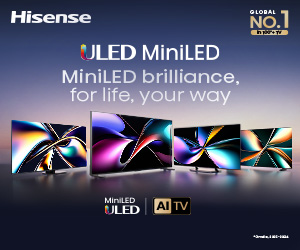


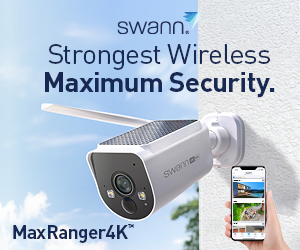

2 comments
Miguel Ángel Bilbao
Hi. Are you planning to review the pixel 10 pro xl? I am waiting for your review, specially the signal strength review, as I travel a lot by car and can’t afford lost calls. Thanks a lot and keep on your excellent work. Cheers from Spain
Ray Shaw
Yes it is here. I alway wait for at least 1 firmware upgrade (that just happened) as out of the box its often very ‘wanky’. Expect later this week or early next week.